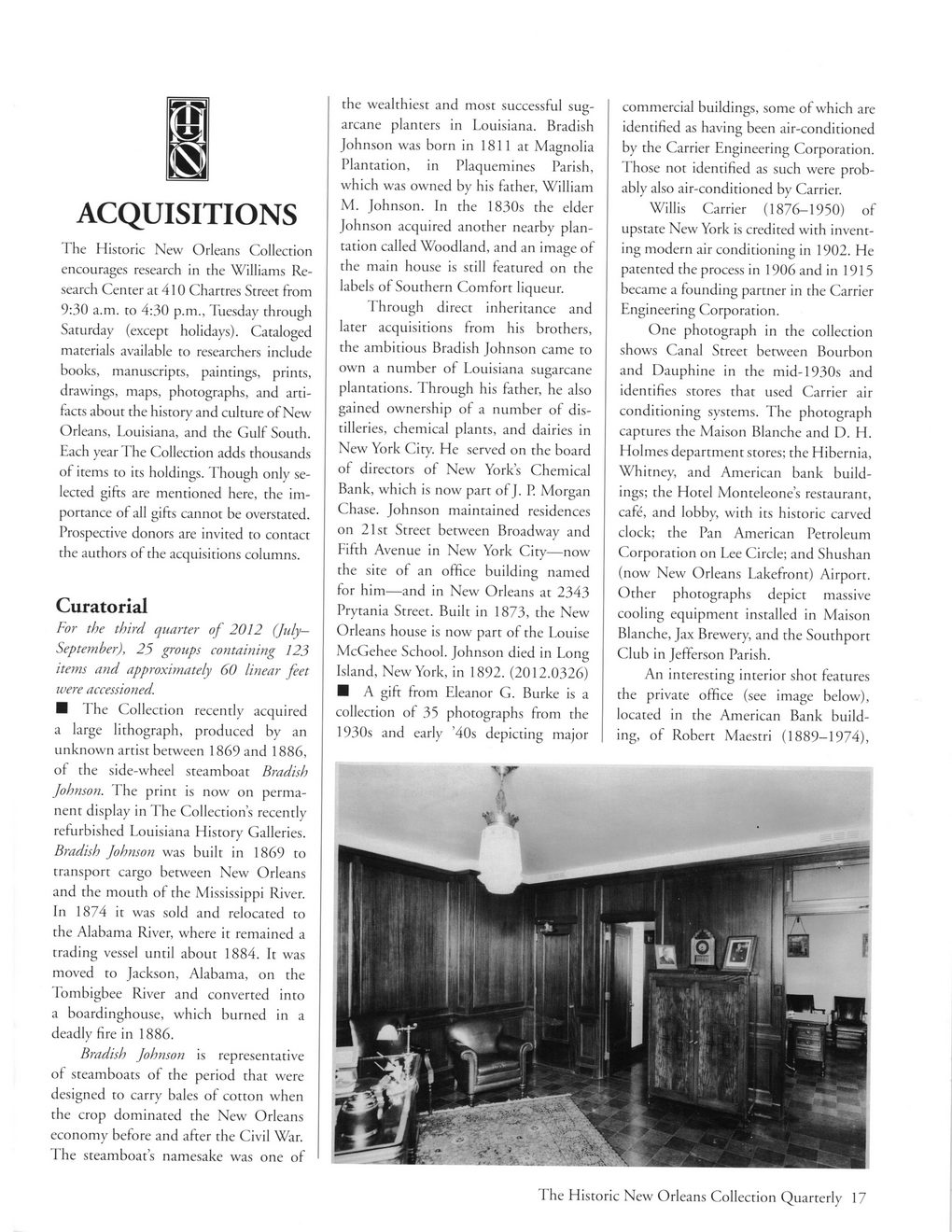This text was obtained via automated optical character recognition.
It has not been edited and may therefore contain several errors.
ACQUISITIONS The Historic New Orleans Collection encourages research in the Williams Research Center at 410 Chartres Street from 9:30 a.m. to 4:30 p.m., Tuesday through Saturday (except holidays). Cataloged materials available to researchers include books, manuscripts, paintings, prints, drawings, maps, photographs, and artifacts about the history and culture of New Orleans, Louisiana, and the Gulf South. Each year The Collection adds thousands of items to its holdings. Though only selected gifts are mentioned here, the importance of all gifts cannot be overstated. Prospective donors are invited to contact the authors of the acquisitions columns. Curatorial For the third quarter of 2012 (July-September), 25 groups containing 123 items and approximately 60 linear feet were accessioned. I The Collection recently acquired a large lithograph, produced by an unknown artist between 1869 and 1886, of the side-wheel steamboat Bradish Johnson. The print is now on permanent display in The Collection’s recently refurbished Louisiana History Galleries. Bradish Johnson was built in 1869 to transport cargo between New Orleans and the mouth of the Mississippi River. In 1874 it was sold and relocated to the Alabama River, where it remained a trading vessel until about 1884. It was moved to Jackson, Alabama, on the Iombigbee River and converted into a boardinghouse, which burned in a deadly fire in 1886. Bradish Johnson is representative of- steamboats of the period that were designed to carry bales of cotton when the crop dominated the New Orleans economy before and after the Civil War. The steamboat’s namesake was one of the wealthiest and most successful sugarcane planters in Louisiana. Bradish Johnson was born in 1811 at Magnolia Plantation, in Plaquemines Parish, which was owned by his father, William M. Johnson. In the 1830s the elder Johnson acquired another nearby plantation called Woodland, and an image of the main house is still featured on the labels of Southern Comfort liqueur. Through direct inheritance and later acquisitions from his brothers, the ambitious Bradish Johnson came to own a number of Louisiana sugarcane plantations. Through his father, he also gained ownership of a number of distilleries, chemical plants, and dairies in New York City. He served on the board of directors of New York’s Chemical Bank, which is now part of J. P. Morgan Chase. Johnson maintained residences on 21st Street between Broadway and Fifth Avenue in New York City—now the site of an office building named for him—and in New Orleans at 2343 Prytania Street. Built in 1873, the New Orleans house is now part of the Louise McGehee School. Johnson died in Long Island, New York, in 1892. (2012.0326) ■ A gift from Eleanor G. Burke is a collection of 35 photographs from the 1930s and early ’40s depicting major ~'*Jr % > commercial buildings, some of which are identified as having been air-conditioned by the Carrier Engineering Corporation. Those not identified as such were probably also air-conditioned by Carrier. Willis Carrier (1876—1950) of upstate New York is credited with inventing modern air conditioning in 1902. He patented the process in 1906 and in 1915 became a founding partner in the Carrier Engineering Corporation. One photograph in the collection shows Canal Street between Bourbon and Dauphine in the mid-1930s and identifies stores that used Carrier air conditioning systems. The photograph captures the Maison Blanche and D. H. Holmes department stores; the Hibernia, Whitney, and American bank buildings; the Hotel Monteleone’s restaurant, cafe, and lobby, with its historic carved clock; the Pan American Petroleum Corporation on Lee Circle; and Shushan (now New Orleans Lakefront) Airport. Other photographs depict massive cooling equipment installed in Maison Blanche, Jax Brewery, and the Southport Club in Jefferson Parish. An interesting interior shot features the private office (see image below), located in the American Bank building, of Robert Maestri (1889—1974), The Historic New Orleans Collection Quarterly 17

New Orleans Quarterly 2013 Winter (17)